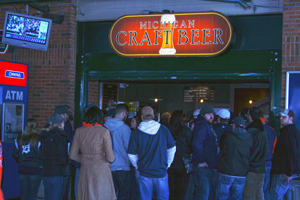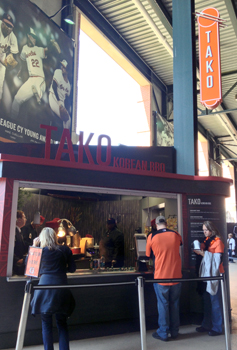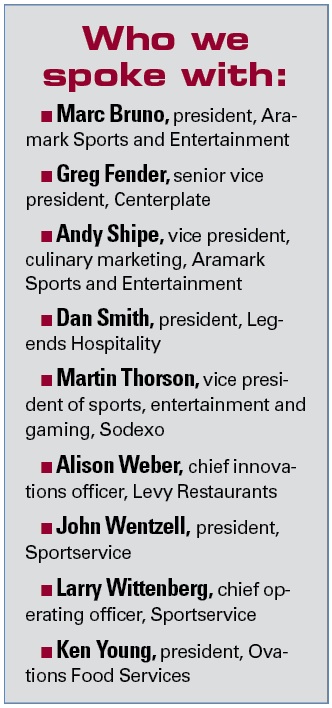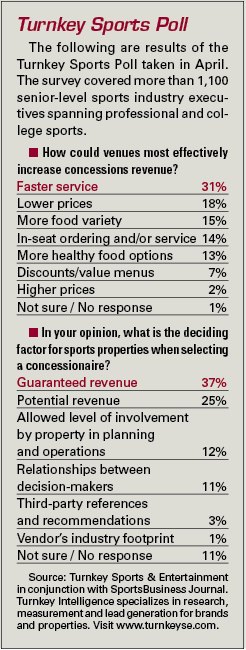Concessionaires continue to seek innovative ways to serve consumers at sports venues, but they do so with the familiar pressures on pricing. The successful strategy is one that balances that desire to improve the service and product mix while still paying close attention to price sensitivities. SportsBusiness Journal facilities writer Don Muret spoke with several leaders in the space about pricing, areas of their business that are experiencing growth, trends they’re watching, recent improvements they’ve made, and how they think the use of technology will evolve in their industry. The following are highlights of what they had to say:
Where are you seeing growth in your company?
MARTIN THORSON, Sodexo: Circuit of the Americas in Austin has been a great project for us. It’s not only built for F1 but to entertain all areas of the business. We do large catering and corporate hospitality, even in our media center, on a daily basis. There is every aspect of the industry at that venue, from the suites to the amphitheater to large event concessions and food courts. We opened with the equivalent of three Super Bowls; 265,000 attended the F1 race over three days. Just the size and scope of the 3.4-mile track and over 400 acres makes it a major venue.
GREG FENDER, Centerplate: We have consistently shown growth over the last few years, weathered the economic storm pretty well. On the sports side, if you look at our [MLB] deals, we’ve been averaging 8 percent growth in revenue. In the NFL, we’ve averaged 5 percent growth. Despite in many venues not getting price increases, we’ve found creative ways to drive per caps and dollars spent.
KEN YOUNG, Ovations Food Services: We picked up some new gaming operations in Phoenix and Green Bay. It took a while to completely understand the business but it’s been good for us. Every tribal community is different, so it’s certainly not cookie-cutter stuff. We do all forms of food service. One of the new ones we opened last year [includes] managing a hotel near Pocatello, Idaho. The other thing that’s so different is that you’re not necessarily going in there just to make money for the casino. What you’re really doing is going in to create a longer stay for the players, taking care of the VIPs. We do have a lot of complimentary things in there so it’s a different level of service than stadiums and arenas.
MARC BRUNO, Aramark Sports and Entertainment: We have some great new partners [Cleveland Browns, Tampa Bay Buccaneers, New Jersey Devils]. In concessions, we’ve seen some nice growth as a result primarily of some of the programmatic elements that we’ve introduced in all leagues. We’re seeing slight to moderate growth in premium areas. We’ve got a general sense of fan spending being a little bit healthier than it was the past year. So when you add those all up, it’s promising for the future, particularly around the average fan and general economic trends that help this kind of business.
DAN SMITH, Legends Hospitality: A recent deal was signing a lease at One World Observatory. We’re already in that business at Cowboys Stadium. Legends handles all the tour business … solicits groups and brings them to the stadium. We said, “Hey, here’s this iconic building in New York. Wouldn’t it be nice if we could use our skills and abilities to bring people worldwide into this building and give them a pleasurable experience?” It’s a total immersive experience in the history of building the [Freedom] Tower. We leased the top three floors and will operate a grab-and-go concept. Obviously there will be a big business for catered events, a cocktail lounge, merchandise outlets. We expect to open June 2015. It clearly positions us for what we call the attractions business.
What trends are you watching?
ALISON WEBER, Levy Restaurants: Certainly everybody is talking about what’s going on with big data — how do you learn more about your business and do something with it. For us it’s not about what the story was last night but what can the story line be in the next five years. That, in general, is going to be shaping the way we make food decisions, the way you make business decisions and service decisions. It’s really creating a different story line, doing something with it with enlightened information.
THORSON: Everybody is looking for that “experience within the experience.” It’s no longer adequate to have a standard concession; you need a club atmosphere where people feel like they’re upgraded into a section with a different level of service … designed for the general admission attendee. It increases revenue and per caps because people get comfortable and want to interact rather than going up and getting one item, walking away and never returning. At Toyota Park, we enhanced the stadium club with small [portions] to make it affordable. Time and time again, they come back and buy. The consumer is too educated and wants an experience with everything they do at the venue and the teams are very vocal about creating that. They’re competing for every attendee, every dollar, and the return fan is a key piece for them.
 |
Sportservice has catered to the trend among younger patrons toward craft beers. This season the company debuted the Michigan Craft Beer stand at Comerica Park in Detroit.
Photo by: Sportservice |
JOHN WENTZELL, Sportservice: I have two 20-something-year-old kids and [craft beers are] what they drink. It’s a trend of many of the younger demographic that are coming to our games and our events. That’s the type of beer they’re drinking outside the arena and the stadium. It’s not inexpensive compared to a domestic draft but there’s value to it for them and we have made a commitment. We debuted a craft beer operation, called Michigan Craft Beer, at Comerica Park in Detroit this season. It’s been terrific.
FENDER: There was a craft cocktail we introduced at the Super Bowl [in New Orleans] called the Crown Royal Bayou Bootleg. We’re seeing a demand for more of that in our markets and are looking to introduce that concept into more of our venues, working with local mixologists with unique products. A lot of the trendy bars these days are featuring specialty cocktails. It’s not something we’ve traditionally done in our sporting environments. Our main bars get hit pretty hard at our peak times and we don’t want to put in too many of those items, but we’re looking to feature specialty ones that we can do very well and do quickly and give some signature items for the account.
YOUNG: In spring training at Salt River Fields in Scottsdale, we had a stand set up with just beers of Colorado and Arizona with the Rockies and Diamondbacks there. If you compare the location with last year’s regular brands, it was up 15 to 20 percent.
What improvements and upgrades have you made?
LARRY WITTENBERG, Sportservice: We have a new concept called Tako Korean BBQ in Baltimore, a Korean beefsteak taco. Every year we hold a food and beverage summit in Buffalo and all of our subsidiaries and culinary people attend. We solicit creative ideas from the field in a competition-based format. They create the look, menu, uniform, design and the products. This [item] was the winner last year in our competition and we took that concept at Sportservice and put it into [Camden Yards] and it’s actually doing double the amount of business [the old stand] did the prior year.
FENDER: What we’re focusing on this year is wine. As a percentage of our total sales, it’s about 3 percent, but there is
 |
A new Korean BBQ concept at Camden Yards in Baltimore came from a competition Sportservice held at its annual food and beverage summit.
Photo by: Sportservice |
ever-increasing demand for high-quality wines. We have specialty wine carts but we haven’t been able to find a way to get these upgraded wines to the masses. We worked with Fetzer this offseason to create an option we’re using with baseball and the NFL. It’s a great package and we’ll see if we can drive that number. The way it’s packaged is going to allow us to put it in concession stands where we can pair it up with beer portables. We don’t need to create a separate location to feature the item. The price is $8 to $12. Six ounces. One of the complaints we hear an awful lot of, if they want a specialty wine, they have to seek it out. People want a quick fix and this product will be readily available.
SMITH: At Cowboys Stadium we’re looking to see how we can add some more premium amenities. We have a vast footprint and a lot more upscale amenities and are looking more along the lines of sit-down restaurants. There are two main clubs and we are looking at an evolution of giving the fans that already have the premium amenities one more choice of a food offering. The good news is when they built the stadium we had the kitchens positioned adjacent to those rooms so it’s not a big expense to convert those to more upscale offerings.
In Yankee Stadium we completely renovated spaces because the fans wanted a different environment. In the Jim Beam Suite right behind home plate … people felt confined because it was off the concourse and didn’t have a view to the field. They wanted to be outdoors so we expanded the footprint and created an outdoor lounge with cocktail bars and a sushi bar … even people not seated in the section want to be there — we have had tons of inquiries on how to upgrade their seats. They want an affordable premium amenity and are willing to buy up for it.
ANDY SHIPE, Aramark: Pat LaFrieda’s filet mignon steak sandwich was a very popular item at Citi Field last year. Now we have expanded it to the Delta Club, which is now a premium offering. Changed up that concept a little bit from a white tablecloth into more of a look and feel of the items that he offers. Down at Turner Field, we have the H&F burger, a local phenomenon, and have seen some very high units sold. Then the extension with [local chef] Bryan Caswell at Minute Maid Park. One of the things we looked at is how do we re-create a hospitality environment partnering with chefs like that with new menu items across concessions as well as premium areas.
Sensitivity over pricing is always an issue. How are you dealing with it with your clients?
FENDER: For the last few years it’s been a challenge to get price increases. Many of our venues have held pricing. There’s been a little bit more flexibility this year. Certainly clients are being price conscious but our venues are thinking about it where they haven’t in the past.
YOUNG: There is a lot of pressure on pricing, especially with [wholesale] beer [costs] going up every year significantly. You look at it and say something’s gotta give. You’ve got to work with your client. Obviously our costs go up. Either it has to get passed along or you rework an agreement some way so that you’re not serving $18 beers. There are ways around it. It comes down to saying, “OK, at what point are we hurting the overall experience?” We’re getting much more into the overall experience of the fan; it’s not just food service. How do we combine that potential all-inclusive with a ticket and what we do, and do we reduce that price a little bit to make that experience a little bit better for the fan? That’s really an important part of where I see the industry going.
BRUNO: Pricing is always going to be an issue beyond food and beverage in the sports world. There’s a lot of talk about what it costs to attend a game, and food and retail plays a big role in that. Part of what we’re trying to do is to continue to work with teams to unlock the value that extends to food and beverage or utilizing it as a driver of creating additional value for the fans. Look, you can’t just raise prices year in and year out and expect people to continue to pay for that. You have to do it in the right way, continue to do it in a fashion … in conjunction with the teams to make sure that the pricing strategy works for the overall value equation for the park.
SMITH: If you go into stadiums and buy a hot dog, you often compare that to a fast-food experience. But if you go into Yankee Stadium and look at some of the offerings, like the [$16] dry-aged steak sandwich, you are comparing the price point to a restaurant entree and there’s absolutely no sensitivity. You’re taking a guy out of a line that would spend X amount on a hot dog and complain about the price and you’re putting him in a line where he spends three times as much and walks away totally satisfied, thinking it was a great value proposition. We’re looking to get the fans to make the choice to migrate up based on more quality offerings. Every year we’ve enjoyed per capita increases because fans buy more.
As far as technology goes, mobile ordering at sports facilities still seems to be hit and miss. Where does it stand with your company?
FENDER: We’ve tried many of the systems out there with the mobile apps … but we’re just not seeing huge utilization. It’s as low as 2 to 3 percent. I’m not sure if it’s the nature of the venue where there are natural breaks in the game and you want to get up and stretch your legs and see what grabs you when you walk up to the stands. I still see it as a trend for the future. We’re working with the 49ers’ new building and, absolutely, tech is a major focus there. That building is designed to have the most flexibility to handle mobile ordering.
YOUNG: Part of it has to do with what the public wants, and in some cases I think we’re five years ahead of the curve, and I say that as an industry. You get a few events that in-seat service is important but, for the most part, people still prefer to get up and get their food and drink. The more use something like that has, the more we probably need to change our operations around a little bit, because you need places to prep and pick up. There might be more with texting you can do. We’ve certainly tried that but it hasn’t taken off.
BRUNO: While we have elements of mobile ordering pretty much across all our venues in one way, shape or form, we’ve seen the adoption rates pretty low from customers. That doesn’t mean it doesn’t work or isn’t attractive. I think it’s just a matter of time before it continues to evolve in a way that it plays a bigger role in the game-day experience with food and beverage.
SMITH: I think the foundation is there and it’s here to stay. Delivery methods will improve over the next few years. The problem with those systems, the way they are designed today, is the adoption rate and fan usage. As smartphones become more sophisticated, you’re going to see the deployment of different types of technology overtake the technology in place today. When you walk up to a cash register, that system is going to know Dan Smith is within five feet and he likes this … it’s going to know all of my preferences and the transaction is going to be concluded without you taking anything out of your pocket. We’re starting to see that now.







